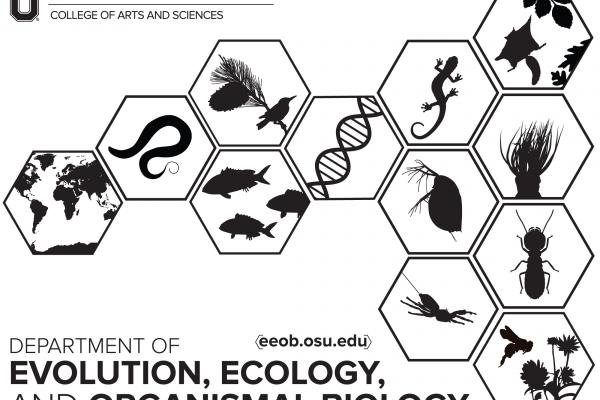July 3, 2017
Publications by EEOB faculty June 1 - June 30

Growth and fecundity of fertile Miscanthus × giganteus (“PowerCane”) compared to feral and ornamental Miscanthus sinensis in a common garden experiment: Implications for invasion.
Maria N. Miriti, Tahir Ibrahim, Destiny Palik, Catherine Bonin, Emily Heaton, Evans Mutegi, Allison A. Snow. 2017. Ecol Evol;00:1–10. https://doi.org/10.1002/ece3.3134
Abstract
Perennial grasses are promising candidates for bioenergy crops, but species that can escape cultivation and establish self-sustaining naturalized populations (feral) may have the potential to become invasive. Fertile Miscanthus × giganteus, known as “PowerCane,” is a new potential biofuel crop. Its parent species are ornamental, non-native Miscanthus species that establish feral populations and are sometimes invasive in the USA. As a first step toward assessing the potential for “PowerCane” to become invasive, we documented its growth and fecundity relative to one of its parent species (Miscanthus sinensis) in competition with native and invasive grasses in common garden experiments located in Columbus, Ohio and Ames, Iowa, within the targeted range of biofuel cultivation. We conducted a 2-year experiment to compare growth and reproduction among three Miscanthus biotypes—”PowerCane,” ornamental M. sinensis, and feral M. sinensis—at two locations. Single Miscanthus plants were subjected to competition with a native grass (Panicum virgatum), a weedy grass (Bromus inermis), or no competition. Response variables were aboveground biomass, number of shoots, basal area, and seed set. In Iowa, all Miscanthus plants died after the first winter, which was unusually cold, so no further results are reported from the Iowa site. In Ohio, we found significant differences among biotypes in growth and fecundity, as well as significant effects of competition. Interactions between these treatments were not significant. “PowerCane” performed as well or better than ornamental or feral M. sinensis in vegetative traits, but had much lower seed production, perhaps due to pollen limitation. In general, ornamental M. sinensis performed somewhat better than feral M. sinensis. Our findings suggest that feral populations of “PowerCane” could become established adjacent to biofuel production areas. Fertile Miscanthus × giganteus should be studied further to assess its potential to spread via seed production in large, sexually compatible populations.
An online photographic catalog of primary types of Platygastroidea (Hymenoptera) in the National Museum of Natural History, Smithsonian Institution
Elijah J. Talamas, Joseph Thompson, Amy Cutler, Samantha Fitzsimmons Schoenberger, Anthony Cuminale, Trenton Jung, Norman F. Johnson, Alejandro A. Valerio, Ashton B. Smith, Victoria Haltermann, Elizabeth Alvarez, Collin Schwantes, Catherine Blewer, Coline Bodenreider, Annika Salzberg, Pei Luo, Debra Meislin, Matthew L. Buffington. 2017. JHR 56: 187–224. doi: 10.3897/jhr.56.10774
Abstract
A photographic catalog of primary types of Platygastroidea housed in the National Insect Collection, National Museum of Natural History, is here made available online at the image database at e Ohio State University (specimage.osu.edu). Following examination of this collection we enact the following taxonomic changes: Leptacis piniella MacGown syn. n. is treated as a junior synonym of Leptacis pinicola MacGown; Sacespalus indicus Mani is transferred to Platygaster Latreille; Platygaster indica Mukerjee is given the replacement name Platygaster chaos Talamas, n. n.; Synopeas rugiceps (Ashmead), comb. n. is transferred from Leptacis Förster; Axea atriclava (Kie er), comb. n. is transferred from Psilanteris Kief- fer; Chakra pachmarhica (Sharma), comb. n. is transferred from Paridris Kie er; Paridris dubeyi Sharma, syn. n. is treated as a junior synonym of Chakra pachmarhica; Holoteleia indica (Mani) is transferred to Opisthacantha Ashmead and given a replacement name, Opisthacantha nomados Talamas, n. n.; Psilanteris nigriclavata (Ashmead), comb. n. is transferred from Anteris Förster; Probaryconus grenadensis (Ashmead), comb. n. is transferred from Monoteleia Kie er; Monoteleia syn.n. is treated as a junior synonym of Pro- baryconus Kie er; Paridris karnatakensis Sharma, syn. n is treated as a junior synonym of Probaryconus cauverycus Saraswat; Probaryconus punctatus (Ashmead), comb. n. is transferred from Oxyteleia Kie er; Triteleia bengalensis (Saraswat), comb. n. is transferred from Alloteleia Kie er; Trimorus varius Fouts, syn. n. and Trimorus pulchricornis Fouts, syn. n. are treated as junior synonyms of Trimorus annulicornis (Ashmead); Neotypes are designated for Gryon leptocorisae (Howard), Idris seminiger (Ashmead), Teleno- mus graptae Howard, Telenomus persimilis Ashmead, and Telenomus rileyi Howard; lectotypes are des- ignated for Cremastobaeus bicolor Ashmead, Oethecoctonus insularis (Ashmead), Oethecoctonus laticinctus (Ashmead) and Probaryconus punctatus (Ashmead).
